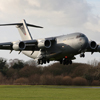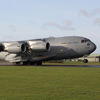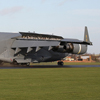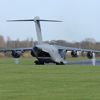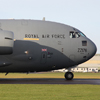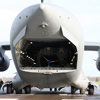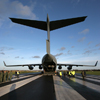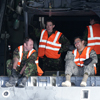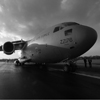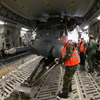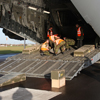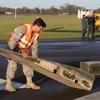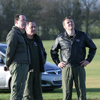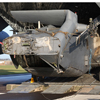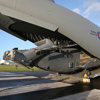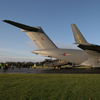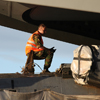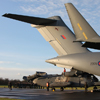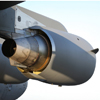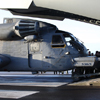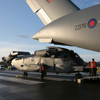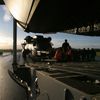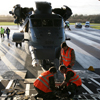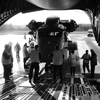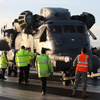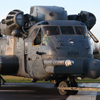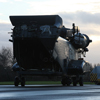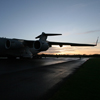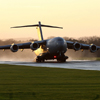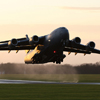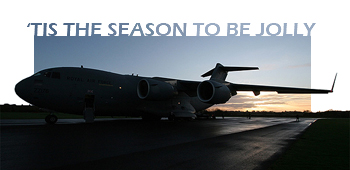
RAF Museum Cosford MH-53 Delivery Feature Report
Wednesday 17th December
December 17th, 2008 represented a significant day for DCAE Cosford. Not only would the resident Royal Air Force Museum take delivery of a new airframe for their collection, it would also be delivered by air inside a 99 Sqn C-17A Globemaster III. In doing so, that aircraft would secure its place in the history books as the largest aircraft to ever land at the airfield.
reports from DCAE Cosford. All photography by the author.
The new arrival would be a former USAF Sikorsky MH-53M Pave Low IV, or Jolly Green Giant, as it's affectionately known. The specific airframe in question, serial number 68-8284, has certainly seen some action during its career stretching a matter of days beyond forty years. Originally built as a Sikorsky S-65/HH-53C-SI, it entered service in August 1968 as a medium-lift Combat Search And Rescue (CSAR) helicopter. Serving in South East Asia in the early 1970s, records indicate that the aircraft was involved in the recovery of two downed aircrews, on September 5th, 1971 and December 19th of the same year. Towards the end of the 70s, '8284' became a resident of our shores, taking up a home with the 67th Air Rescue and Recovery Squadron (ARRS) at RAF Woodbridge in Suffolk.
One of nine MH-53Hs and 32 HH-53s converted to 'MH-53J Pave Low III Enhanced' classification, this gave the aircraft a low-level, long-range Special Operations standard, with uprated engines, more armour, Forward Looking Infra-Red (FLIR), Global Positioning System (GPS), Doppler Navigation Systems (DNS), Terrain-Following and Terrain-Avoidance Radar, on-board computer and integrated avionics. These upgrades meant that the aircraft was now described as offering low-level, long-range, undetected penetration into denied areas, day or night, in adverse weather, for infiltration, exfiltration and resupply of Special Operations Forces. These upgrades were performed sometime between 1986 and 1990.
On June 1st, 1988 the 67th ARRS was redesignated as the 67th Special Operations Squadron (SOS), and following the closure of their homebase in April 1992, the unit relocated to RAF Alconbury in Cambridgeshire. '8284' later went on to receive the MH-53M Pave Low IV upgrade, incorporating an Interactive Defensive Avionics System/Multi-Mission Advanced Tactical Terminal, providing significantly enhanced defensive capabilities.
The latter part of the aircraft's career was spent with the 20th SOS, the 'Green Hornets', based at Hurlburt Field AFB, FL, USA, falling under the umbrella of the 1st Special Operations Group. The unit saw extensive service in the Persian Gulf and in Bosnia during this time, with the type finally being withdrawn from service on the September 30th, 2008.
After being gifted to the RAF Museum at Cosford, the helicopter was repositioned to RAF Brize Norton from Baghdad, Iraq, by a USAF C-17A at the end of October.
Originally the plan had been to road the airframe to Cosford from Brize, but 99 Sqn were of the opinion that this represented an excellent training opportunity for them. Firstly, there would be an opportunity to operate into and out of an airfield with a runway length of sub-4000ft - something which the C-17A is perfectly capable of doing. It was also perceived to be of significant training value for the movers - the men and women responsible for the loading, securing and unloading of cargo in to and from the hold of the C-17A - for whom this provided a rare chance to handle some non-British hardware, complete with its own quirks and nuances.
Captaining the aircraft was OC 99, Wg Cdr Simon Edwards. Simon took command of the Squadron in May of this year for his second tour on the type. Prior to that he'd operated C-130Ks and been a Qualified Flying Instructor (QFI) on the Tucano at RAF Linton-on-Ouse.
Joining Simon on the flight deck was Sqn Ldr Keith Hewitt, part of the initial cadre of pilots trained on the C-17, and currently 99 Sqn's most experienced pilot on type with more than 4760 hours to his name.
The Air Loadmaster for the mission was Sqn Ldr Dave Thompson, 99 Sqn's Second In Command (2IC). Like Keith, Dave was one of the initial batch of aircrew selected to bring the aircraft into RAF service.
Much to the frustration of the enthusiast community present on the railway platform at the 24 approach end, the Globemaster appeared at the 06 end around 1245 hrs, performing a run and break, before setting up for an approach to that same runway. Having been placed down just after the piano keys, the aircraft was brought to a standstill with about a third of the 3871ft of Cosford's runway remaining.
The crew reversed the aircraft back to the 06 threshold where she was to be unloaded. First the ramp was lowered, and then the movers produced some wooden extensions from inside the aircraft. The ramp was raised slightly and part of the wooden extension blocks was placed beneath the ramp, effectively shallowing the angle of the whole ramp.
The gearbox and other parts from the top of the helicopter had already been removed prior to transit, and were in actual fact already present at Cosford. This was done simply because the MH-53 wouldn't have fitted inside the C-17 with them still in place. For the transit the aircraft had been secured in place with heavy metal chains, and with these removed, she was carefully winched, inch by inch out of the now open and fully extended ramp, with the movers stopping periodically and chocking her to make sure the MH-53 airframe was going to be clear of the sides and roof of the C-17 at all times.
Finally, after approximately an hour and a half (which had included various press tours and interviews), aircraft '8284' was resting on the Cosford tarmac, completely separated from her 'mother-ship', and all set to take up her temporary home in Hangar 2 for the night.
While the extraction had gone smoothly, it later emerged that there had been some concerns raised as she was being towed away. The new handlers could smell burning and were reporting strange handling under braking. Naturally they were concerned there may have been a brake fire, so the fire services were called to check out the situation but found nothing to be wrong.
The Globemaster wouldn't be empty for its return journey to Brize. One of 99 Sqn's cars which had travelled separately that morning was loaded on-board, and at approximately 1535hrs, the largest aircraft to ever land at Cosford once again returned to the skies in the most spectacular fashion, again, with a not inconsiderable amount of runway remaining, really emphasising the tremendous short-field performance of the type.
The Museum's new arrival will spend some time in their Michael Beetham Conservation Centre before taking its rightful place at Cosford's multi-award winning National Cold War Exhibition in Spring 2009.

